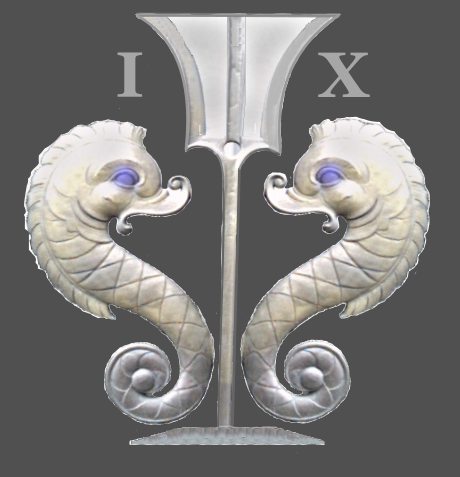Newfoundland - Thrombolites and Vikings
/We boarded the ferry in Blanc Sablon, Quebec for the 17 mile/1:45 hour trip across the Strait of Belle Isle to Saint Barbe, Newfoundland. The passage was calm. We spotted an iceberg off the port side. Gulls cried. Eider ducks swam in flotillas and before we knew it, we had arrived. Welcome to ‘The Rock’, the name affectionately given to Newfoundland.
If you look closely in the background, you can see an ice berg floating in the Strait of Belle Isle.
David had done his homework and sussed out a free RV parking spot in Flowers Cove only 10 minutes up the road. A huge gravel parking lot at the end of a spit overlooking the bay had plenty of room for us and the 6 or 7 other campers that spent the night there.
Flower Cove allowed free camping in this large gravel lot overlooking the bay.
Across the bay, we could see the Flowers Cove Lighthouse.
Flowers Cove Lighthouse
We’d seen a sign for the Thrombolite Trail as we entered town and we were curious about them. We seemed to remember ‘thrombolites’ from Australia, but that was centuries ago and our memories were rusty.
Though the winds were gusty, the 1.1 mile roundtrip trail was quite pleasant. A crushed rock path wound its way along the coast. A boardwalk took us over the boggy bits.
The trail was in good shape, but the signage and boardwalk had seen better days.
Marsh marigolds, bog beans, and rose root lined the path.
Thrombolites are rock-like formations found in only a few places in the world including the west coast of Australia and Flower’s Cove. Formed from calcified microorganisms in coastal wetland areas, scientists believe that thrombolites were some of the earliest lifeforms on Earth. Thought to be ~570 million years old, scientists postulate that they produced the oxygen that made subsequent lifeforms possible. And here they were… staring us right in the face. Actually, no staring occurred because they look like smooth, white limestone rocks.
Thrombolites aren’t very animated, but they certainly are old.
We returned to Blanche and watched a beautiful sunset on the bay.
The next morning we headed north on the Viking Trail (Route 430N) to L’Anse aux Meadows National Historic Site and also a UNESCO World Heritage Site, located at the tip of Newfoundland’s Great Northern Peninsula.
According to the UNESCO website, “L’Anse aux Meadows contains the excavated remains of a complete 11th-century Viking settlement, the earliest [authenticated] evidence of Europeans in North America.”
From the historic site’s brochure, “Under Leif Eiriksson’s leadership, the group of 60-90 people set up a sturdy encampment of turf-walled buildings that served as an over-wintering base for exploring”. The Vikings call this land Vinland.
David checks out a replica Viking Knarr n the Visitor Center Exhibit area.
We checked out the exhibits in the Visitor’s Center then walked a long, meandering boardwalk trail to the archeological site and several reconstructed sod huts. The path is bordered by tuckamores, a Newfoundland word describing spruce trees stunted and bent by coastal winds. We were to learn many words and expressions unique to Newfoundland in our time on the island.
A long boardwalk lined in Tuckamores led to the Viking encampment.
Along the way, we walked under a bronze arch sculpture entitled “Meeting of Two Worlds”. Created by Luben Boykov of Newfoundland and Richard Brixel, the sculpture celebrates the first meeting of Europeans and Indigenous North Americans.
“Meeting of Two Worlds”
The recreated Viking encampment area was excellent. The Viking camp consisted of several buildings thought to replicate those originally standing here. All were turf-sided with vents for ventilation and smoke exhaust.
Entering the Viking encampment
Inside the Long House a fire was burning.
Thora and her maid were busy mending
Ragnar the blacksmith was fabricating iron nails.
The archeological site is signed, but it’s really not much more than grassy hills and you have to trust the signs and your imagination to visualize and appreciate what you’re seeing.
We returned to the Viking Trail and traveled a 1/2 mile further to the end of the road and the picturesque little fishing village of L’Anse aux Meadows in order to see the bronze statue of Lief Eiriksson.
We got a kick out of a sign an industrious local had erected outside his house.
We camped at Pistolet Provincial Park for the night. On our way to the park, we were surprised to see a huge bull moose about 100’ off the road. Though we’d seen dozens and dozens of ‘watch out for moose’ signs, this was the first moose we’d seen on our entire trip across Canada.
We were quite surprised to finally spot a moose.
The evening was warm and sunny and a total delight. The campground was spacious and quite private, surrounded by black spruce and bunchberry. We sat out in our camp chairs appreciating the night and our good fortune to be here.
Next time, we head south on the Great Northern Peninsula to Port au Choix National Historic Site further south on the Great Northern Peninsula. Come along for the ride!

























